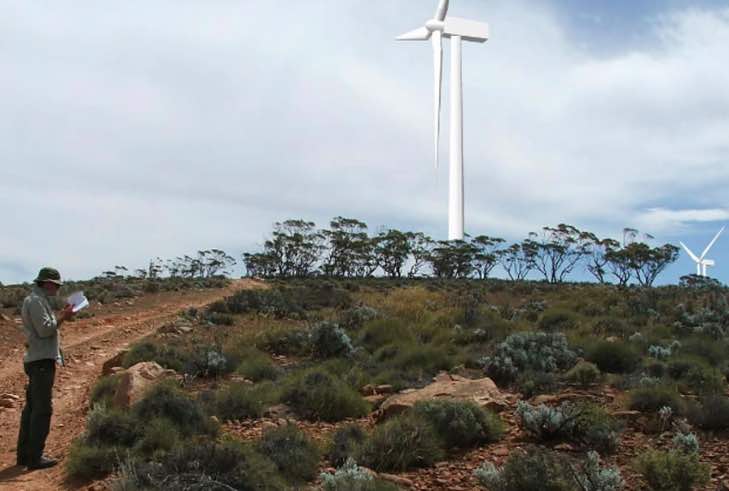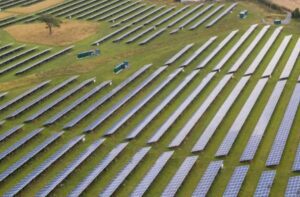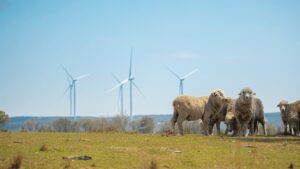
The 212MW Lincoln Gap wind project near Port Augusta is to be the third wind farm in South Australia to add battery storage to its operations, with news that it will build an “unsubsidised” 10MW/10MWh fast response battery array.
The announcement came as project developers, the Singapore-based Nexif Energy announced they had secured $150 million in debt finance from the Clean Energy Finance Corporation, paving the way for construction of the first stage of the project, 126MW, to begin later this month.
The second stage is likely to come with additional battery storage, probably another 20MW/20MWh, although the size and configuration – and whether it focuses on FCAS, or time shifting, or both, will depend on the results of the first stage.
Both companies are hailing the addition of battery storage as signs that the “next” phase of the clean energy transition is well under way.
It follows the Tesla big battery (100MW/129MWh), next to the 315MW Hornsdale wind farm, and the 30MW/8MWh battery to be put next to the 96MW Wattle Point wind farm. (See our round-up here).
Lincoln Gap also highlights the massive change occurring at the old industrial centre at the top of the Spencer Gulf.
Port Augusta, which has seen its two coal generator close in recent years, it is also witness to a 220MW Bungala solar project under construction, and a 1.1GW proposal for wind, solar and battery storage at DP Energy’s Port Augusta Renewable Park.
And there is the 150MW Aurora solar tower with eight hours of storage from molten salt, and a new pumped hydro storage project called Goat Hill has also emerged.
In Whyalla, the owner of the steelworks his proposing 1GW of solar, battery storage, pumped hydro, demand management and co-generation in a dramatic transformation of the way heavy industry sources energy in Australia.
CEFC wind sector lead Andrew Gardner said large-scale battery technology is developing rapidly, and it expects the costs of battery storage to fall significant, just as happened with wind and solar.
“This is the first development project in Australia which has been able to secure debt finance for a grid-connected large-scale battery component on a non-subsidised basis,” Garnder said.
“It provides an important financing model for other developers and investors wanting to be at the forefront of closer integration of renewables into the grid.”
He quoted Bloomberg New Energy Finance (BNEF) forecasts that Australia will have more than 29,000MW of flexible capacity installed by 2040, including both large-scale and small-scale batteries and demand response capability
He said this growth will support better management of variable generation as lower cost renewables become an increasingly important part of the electricity mix.
The CEFC said the combination of batteries at Lincoln Gap, Hornsdale and Wattle Point will provide a significant amount of frequency response services to the South Australian grid.
The Lincoln Gap project is expected to be operational from mid-2018.
It has secured two long term Large Scale Generation Certificate (LGC) agreements with ERM Power and a long-term electricity offtake agreement with Snowy Hydro, but it is also reserving a significant share of its output for the merchant market.
Zeki Akbas from Nexif Energy Australia said “bundled” contracts – where developers of wind or solar projects deliver all the LGCs and output to a single retailer – were not doing great favours to wind farm developers.
Construction of the wind farm, 15 kilometres west of the Spencer Gulf town of Port Augusta, was expected to begin by the end of November and both the wind farm and the battery storage should be in place by the end of 2018.
“We are pleased to include grid-scale battery storage as an essential part of the wind farm investment and were happy to receive strong support and encouragement from the CEFC as our investment partner,” he said in a statement.
“With the scalable battery storage at Lincoln Gap we will be able to offer more flexibility to the national grid and improve the reliability of the system.”
The Lincoln Gap wind farm will feature Senvion 3.6M140 EBC turbines, which are designed for moderate and strong wind speeds to enable optimised load management even in challenging wind conditions.
CEFC recently made a $94 million investment in Australia’s first fully integrated wind, solar and battery project, at the Queensland Kennedy Energy Park.
Gardner said he expected investors will be increasingly attracted to such large-scale hybrid renewable energy projects as the next wave of investment and technological innovation.
“By financing these integrated generation and storage projects, the CEFC is demonstrating how Australia can continue to increase our renewable energy capacity, while providing the important ancillary benefits necessary for grid stability and security.”









